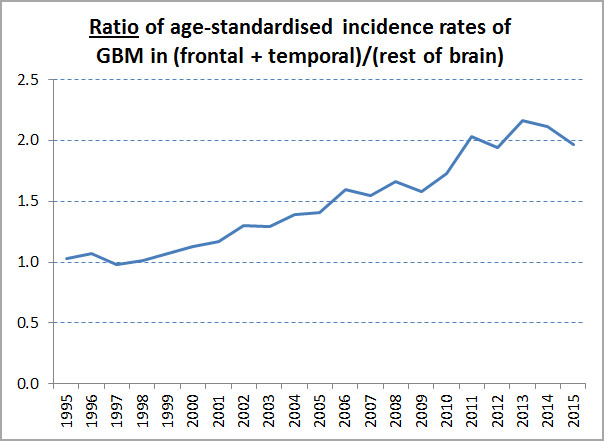Location, Location, Location
Aggressive Brain Tumors Tell a Story
GBM Rise Only in Frontal and Temporal Lobes
A U.K. epidemiologist has confirmed that glioblastoma (GBM), the most aggressive type of brain tumor, is on the rise in England. In a new paper, Frank de Vocht of the University of Bristol reports that he sees a significant and consistent increase in GBM in the frontal and temporal lobes of the brain over the last 20-30 years.
Alasdair Philips, an independent researcher based in Scotland, and three colleagues first documented the increase last March (see our story). It was not due to improved diagnosis, they said, but they could not pinpoint which “environmental or lifestyle factor” was responsible. There was one clear possibility: cell phones.
Not so, says de Vocht. His model —based on “synthetic counterfactuals,” a somewhat arcane modeling technique— tells him that whatever might be at work, it is “unlikely” to be cell phones. De Vocht maintains that the most probable explanation remains improved diagnosis, “especially in the elderly.”
Philips’s paper has been widely circulated, but no one, until de Vocht, had addressed it in public. The U.K. government will likely welcome his analysis: It supports the official position that cell phones do not threaten public health.
De Vocht is a member of an influential advisory group called COMARE, the Committee on Medical Aspects of Radiation in the Environment. “COMARE has always been about ionizing radiation; de Vocht appears to be the only member who has published on the non-ionizing side of the spectrum,” said Denis Henshaw, one of Philips’s collaborators. Henshaw is an emeritus professor at the University of Bristol, where de Vocht is now a lecturer.
When Microwave News asked Philips to respond, he sent us the following graph:

“It clearly shows that most of the increase in GBM occurred in just two regions of the brain, the temporal and frontal lobes,” Philips said. “There’s no reason to believe that better diagnosis would favor one part of the brain over another. I’m not saying it’s necessarily mobile phones, but surely that’s the most obvious possibility. After all, the temporal and frontal lobes are exposed to the most radiation when a phone is held up to the ear.”
“I can’t think of anything else to account for what we are seeing,” Philips said, “What else is there?”
De Vocht Comments, Philips Offers Another Graph
On reading our story, Frank de Vocht commented that he did not find Alasdair Philips’s graph surprising because, he explained, something like 80-90% of GBM occur in the frontal and temporal lobes. That’s where you would “see the largest effect,” he wrote in an e-mail.
Once again, we asked Philips for a reply.
“I am mystified by de Vocht’s conclusions and comments,” he wrote back. He sent us another graph:

“As you can see, from 1995 to 1997, there was about the same number of tumors in the frontal and temporal lobes as there were in the rest of the brain,” he wrote. The ratio of cases was about one.
“Now, there are twice as many and the ratio in the graph has risen to two,” said Philips. “We can clearly see a doubling.”
The doubling held true even after correcting for the aging population, according to Philips. (People get more brain tumors as they get older.)
In absolute numbers, both groups had just over 300 cases of GBM in 1995; while in 2015, there were 1379 cases in the frontal and temporal lobes and 705 in the other regions of the brain. Over the same period, the number of GBM not classified to a specific brain region stayed fairly constant at about 500, Philips noted.
